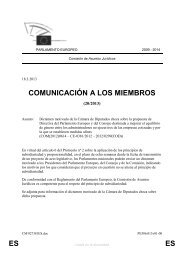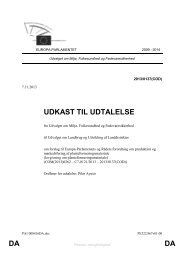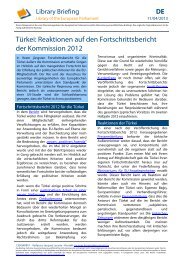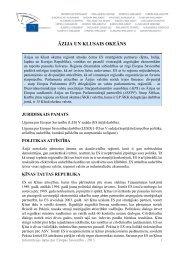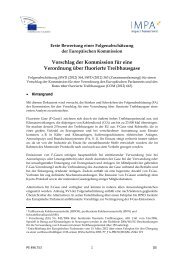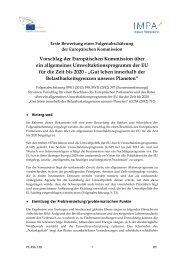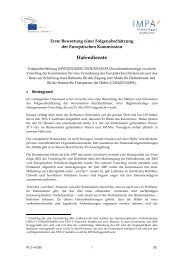Link to the study - European Parliament - Europa
Link to the study - European Parliament - Europa
Link to the study - European Parliament - Europa
You also want an ePaper? Increase the reach of your titles
YUMPU automatically turns print PDFs into web optimized ePapers that Google loves.
Policy Department D: Budgetary Affairs<br />
____________________________________________________________________________________________<br />
The management selects and controls external consultants that send <strong>the</strong>ir experts <strong>to</strong> work with<br />
<strong>the</strong> managing organisation (ei<strong>the</strong>r with <strong>the</strong> management or <strong>the</strong> work level, whatever<br />
appropriate for <strong>the</strong> task).<br />
The PMU is fully integrated in<strong>to</strong> <strong>the</strong> managing organisation level, defined and controlled by its<br />
management.<br />
The managing organisation’s budget control issues are a task of <strong>the</strong> national administration<br />
(source 1, <strong>the</strong> institution responsible for national fund control) as well as of EBRD (source 2,<br />
control on behalf of <strong>the</strong> EC budget contribution) and serves as control of <strong>the</strong> due diligence.<br />
Improvements of <strong>the</strong> management in <strong>the</strong> three countries are still possible. This involves on <strong>the</strong> one<br />
side <strong>to</strong> streng<strong>the</strong>n <strong>the</strong> management’s role as a planner of strategic decisions (see chapter 2.4.3), but<br />
on <strong>the</strong> o<strong>the</strong>r side also <strong>to</strong> hold management responsible for any failures, for<br />
perceiving/evaluating/communicating risks and for consistently controlling work planning and work<br />
progress.<br />
In order <strong>to</strong> streng<strong>the</strong>n <strong>the</strong> role of <strong>the</strong> management a clear definition of its tasks should be<br />
established. One of <strong>the</strong> tasks should involve <strong>the</strong> complete internal control of <strong>the</strong> work progress, <strong>to</strong> be<br />
reported using meaningful and significant indica<strong>to</strong>rs <strong>to</strong> <strong>the</strong> supervising organisations.<br />
The management and its control institutions, not any outside institutions, should be held responsible<br />
for all aspects that involve control over <strong>the</strong> decommissioning process.<br />
4.5. PROJECT AND RISK MANAGEMENT<br />
As described in chapters 3.4.3 and 3.4.4 project and risk management should govern <strong>the</strong> whole<br />
planning process of <strong>the</strong> decommissioning project.<br />
This chapter identifies <strong>the</strong> approaches in <strong>the</strong> three countries and compares <strong>the</strong>m with <strong>the</strong> best<br />
practice.<br />
4.5.1. Project and risk management approach in <strong>the</strong> decommissioning projects<br />
Bulgaria<br />
ANNEX 3, page 150, lists several examples of projects and <strong>the</strong>ir delay. Among <strong>the</strong>m are well<br />
foreseeable reasons for delays that can well be expected and should be detected with a functioning<br />
systematic project and risk management approach.<br />
E.g. <strong>the</strong> time that was required for unloading <strong>the</strong> pools was underestimated by <strong>the</strong> consultant group.<br />
The described reasons (delay in finishing <strong>the</strong> external s<strong>to</strong>rage facility through detection of unsuitable<br />
underground conditions and delayed cask delivery) point <strong>to</strong> underestimated risks that were not<br />
correctly evaluated. The condition of <strong>the</strong> underground of a site for a facility must well be known if <strong>the</strong><br />
planning involves state-of-<strong>the</strong>-art foundation ground examination as part of <strong>the</strong> site identification,<br />
site selection and evaluation process. So risks of this kind are foreseeable, if <strong>the</strong> planning is following<br />
rules that allow for early risk identification.<br />
The example shows that project and risk management are still <strong>to</strong> be vastly improved. The responsible<br />
decommissioning organisation has <strong>to</strong> take control over all relevant issues and has <strong>to</strong> have <strong>the</strong><br />
112




